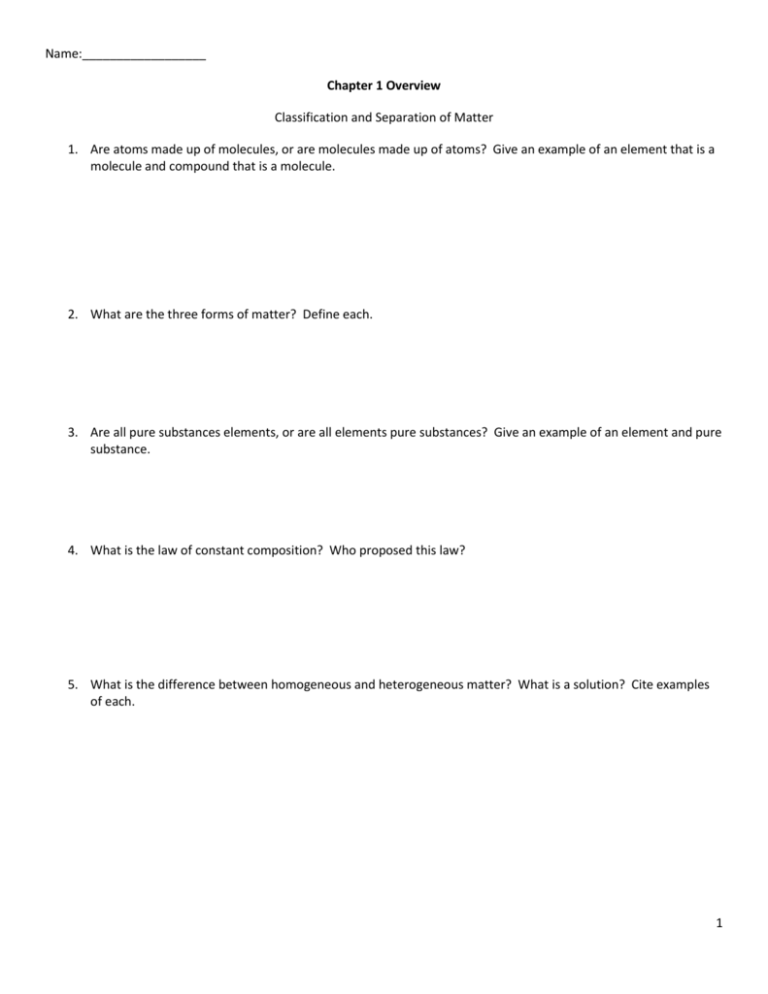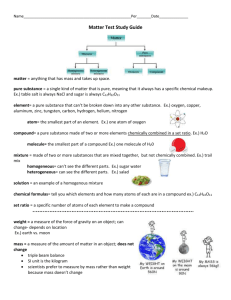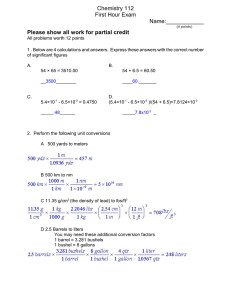Name: Chapter 1 Overview Classification and Separation of Matter
advertisement

Name:__________________ Chapter 1 Overview Classification and Separation of Matter 1. Are atoms made up of molecules, or are molecules made up of atoms? Give an example of an element that is a molecule and compound that is a molecule. 2. What are the three forms of matter? Define each. 3. Are all pure substances elements, or are all elements pure substances? Give an example of an element and pure substance. 4. What is the law of constant composition? Who proposed this law? 5. What is the difference between homogeneous and heterogeneous matter? What is a solution? Cite examples of each. 1 6. Draw the flow chart for the classification of matter. 7. Classify each of the following as homogeneous or heterogeneous. a. Soil b. Tap water c. The atmosphere d. A carbonated soft drink e. Gasoline f. A solution of ethanol and water g. The air in this room h. Split pea soup 8. Classify each of the following as a mixture or a pure substance. i. Water j. Blood k. The oceans l. Orange juice m. Iron n. Brass o. Uranium p. Wine q. Leather r. Table salt (NaCl) i. Of the pure substances, which are elements and which are compounds? 2 9. Differentiate between a chemical property and physical property. Cite examples of each. 10. Compare and contrast intensive and extensive properties. Cite examples of each. 11. Name and define ways of separating mixtures. What types of mixtures could be separated by each type. 12. The properties of a mixture are typically averages of the properties of its components. The properties of a compound may differ dramatically from the properties of the elements that combine to produce the compound. For each process described below, state whether the material being discussed is most likely a mixture or a compound, and state whether the process is a chemical change or a physical change. s. An orange liquid is distilled, resulting in the collection of a yellow liquid and a red solid. t. A colorless, crystalline solid is decomposed, yielding a pale yellow-green gas and a soft, shiny metal. u. A cup of tea becomes sweeter as sugar is added to it. 3 13. What are the differences between a hypothesis, law and theory? 14. Differentiate between quantitative and qualitative data. 15. What is the official unit of measurement for the United States? 16. What are SI units and where did the come from? 17. Without referencing your book, conversion sheet, or your cousin Vinny; how many milli-‘s are in a base unit? Centi-’s? Deci-‘s? Micro-‘s? Base units in a kilo-? 18. What is temperature? How does it determine heat flow? 19. What are the different temperature scales? What are the freezing points and boiling points in these temperature scales? 20. Convert the following temperatures. a. 31°C K & °F b. -40°F K & °C 4 21. What is density? What units is density usually, but not always, expressed in? What is the density of water at room temperature (25°C)? Gold? 22. Calculate the density of mercury if 1.00 x 102 g occupies a volume of 7.36 cm3. 23. Calculate the volume of 65.0 go of the liquid methanol (wood alcohol) if its density is 0.791 g/cm3. 24. What is the mass in grams of a cube of gold if the length of the cube is 2.00 cm? 25. What is the difference between exact and inexact numbers? Cite examples of each. 26. What is uncertainty in numbers? Where does this occur? 27. Differentiate between precision and accuracy. 28. Why are significant figures and why are they used? 5 29. What are the rules for zeroes and significant figures? 30. Determine the number of significant figures in the following measurements. a. 12.01 g b. 45.0 cm c. 3.78 L d. 0.0693 m e. 1 turkey f. 328,000,000,000 turkeys 31. What are the rules for multiplication/division of significant figures? Addition-subtraction? 32. Complete the following calculations using significant figures rules? a. 24.8 g / 12.3 cm3 b. 20.4 g -8.106 g c. (2.239 x 105 g)/(34.2 cm3 - 31.0 cm3) 1.39 s 33. What is dimensional analysis? What is the key to dimensional analysis? 6 34. Covert the following: a. 38.325 lbs into grams b. 10.0 mL into L c. 28.3 cm into m d. 34.0 g into mg e. 31.0 ft3 into cm3 35. In Shakespeare’s Richard III, the First Murderer says: “Take that, and that! [Stabs Clarence] If that is not enough, I’ll drown you in a malmsey butt within!” Given that 1 butt = 126 gallons, in how many liters of malmsey (a foul brew similar to mead) was the unfortunate Clarence about to be drowned in if “that” wasn’t enough? 36. Science fiction often uses nautical analogies to describe space travel. If the starship U.S.S. Enterprise is traveling at warp factor 1.71, what is its speed in knows? (Warp 1.71 = 5.00 times the speed of light; speed of light = 3.00 x 108 m/s; 1 knot = 2000 yd/h, exactly.) 7 37. The density of air under ordinary conditions at 25°C is 0.00119 kg/L. How many kilograms of air are in a room that measures 11.0 ft. x 11.0 ft. and has a 10.0 ft. ceiling? 1 in. = 2.54 cm (exactly); 1000 cm 3 = 1 L 8






